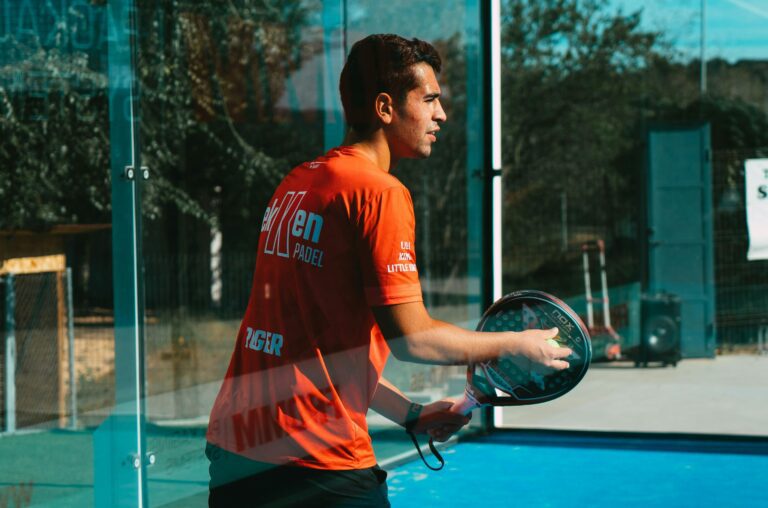If you’ve ever watched a padel match and thought, “How do these guys make the ball curve like a possessed boomerang?”—you’re not alone. The slice serve is one of the most satisfying (and annoying for your opponent) weapons in padel. If done right, it can turn you into a serving menace, forcing weak returns and giving you the upper hand right from the start of the point.
Now, if you’re a beginner, chances are your serve is currently about as intimidating as a toddler throwing a tennis ball. No worries—I’ve been there. We all start somewhere. So, let’s break this down in a way that makes sense, so you can start slicing like a pro and stop giving your opponent easy sitters.
Why Use a Slice Serve in Padel?
Because it works. Simple as that.
The slice serve isn’t just for show—it has real strategic value. It stays low, skids off the glass, and makes life miserable for your opponent. Unlike a flat serve, which is easier to read and return, a well-executed slice can:
- Stay low after bouncing, making it harder to attack.
- Skid off the side wall, confusing opponents who don’t anticipate the curve.
- Create awkward angles, forcing weak returns and giving you an easy first volley.
In short, the slice serve is your secret weapon to start points on the front foot instead of scrambling for survival.
The Mechanics of a Slice Serve
Alright, let’s get technical—but not too technical. No one needs a physics lecture here. The key to a good slice serve is all about how you make contact with the ball.
1. Grip Matters
First, let’s talk about your grip. If you’re using the forehand grip for your serve, congratulations—you’re making things ten times harder for yourself. Switch to the continental grip (yes, the same one used for volleys and dinks). This grip allows for better wrist movement and makes slicing the ball far easier.
2. Ball Placement
Don’t just drop the ball like you’re feeding pigeons. You need control. Hold the ball with your non-dominant hand at hip height and place it slightly in front of you. You want to make contact when the ball is in the perfect spot—not reaching too far or hitting it behind your body.
3. Swing Path and Contact Point
Here’s where the magic happens. Instead of hitting the ball straight on, you want to:
- Brush the side of the ball, creating spin.
- Make contact at about waist height.
- Follow through across your body to accentuate the slice.
Think of it like slicing through a loaf of bread (except way cooler and less carbs involved). The key is not to smack the ball, but rather to graze it, making sure it gets that sweet side spin.
4. The Follow-Through
A good slice serve doesn’t stop at contact. Your follow-through should go across your body, not straight forward. This helps maintain spin and keeps the ball low. If your serve keeps popping up, check your follow-through—you’re probably not committing to the slice enough.
Common Mistakes and How to Fix Them
Let’s be honest—your first few slice serves are probably going to look… questionable. That’s normal. But instead of getting frustrated, here are the most common mistakes beginners make and how to correct them.
Mistake #1: Hitting Too Flat
- Problem: Your serve isn’t slicing, and your opponent is teeing off on it like a baseball pitch.
- Solution: Focus on brushing the side of the ball rather than hitting through it. Exaggerate the motion at first to really feel the spin.
Mistake #2: Ball Bouncing Too High
- Problem: The serve bounces up instead of skidding low.
- Solution: Keep your wrist loose and make sure you’re hitting the ball at the right angle. Too much forward motion can cause the ball to pop up.
Mistake #3: Hitting the Ball Too Hard
- Problem: You’re blasting the ball like you’re trying to serve an ace in tennis.
- Solution: The slice serve is more about spin than power. Relax your arm and focus on control over speed.
Mistake #4: Poor Ball Toss
- Problem: Your toss is inconsistent, making it impossible to hit a good slice.
- Solution: Keep your toss simple and controlled. You’re not launching it into orbit—just placing it in the right spot for your swing.
Practicing Your Slice Serve
Okay, so you’ve got the technique. Now what? Practice. And then practice some more. Here’s a simple drill to dial in your slice serve:
- Shadow Swings – No ball, just practicing the motion. This helps build muscle memory.
- Half-Speed Serves – Focus on spin and control rather than power.
- Target Practice – Place cones or targets in the service box and try to hit them.
- Wall Practice – Serve against the back glass to see how the spin reacts.
- Match Play – Try it out in real points to get comfortable under pressure.
Final Thoughts
If you want to step up your padel game, the slice serve is a must-have. It’s not about overpowering your opponent—it’s about being smarter than them. A well-placed, well-spun slice serve can give you the edge before the rally even starts.
So, go out there, start slicing, and watch as your opponents start questioning their life choices. And if they ask how you suddenly got so good at serving, just give them a knowing smile and say, “Trade secret.”
#1 Resource For Padel Guides, News and Reviews Daily Stay Ahead with Expert Insights, Product Reviews, and Guides.





